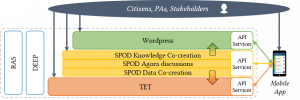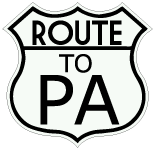In order to engage citizens, the idea is to foster the collective generation of information and knowledge by forming communities around topics of interest. Whilst in the traditional access to Open Data citizens are alone, within the ROUTE-TO-PA platform activities are social and collaborative, the focus is on topics and relevant questions to be discussed by using Open Data in a social and collaborative manner.

The ROUTE-TO-PA platform has mainly three sets of functionalities.
The Transparency Enhancing Toolset (TET) provides to governments and PAs a storage for datasets with relevant metadata, a catalogue of categorised open datasets for users and a search engine. It is a set of extensions for the CKAN platform to deliver greater data transparency, quality and understandability as well as analytical tools. TET completely redesigned the overall user interface (UI) including a customized theme for CKAN to improve its pleasantness, usability, obtaining a better user satisfaction; overcoming in this way the CKAN usability barrier. Instead to start with a list of datasets available OD, it simplifies the main page showing a text field to type keywords to search within the repository as in many search engines currently on the market. In terms of UI, TET provides an improved presentation of results and dataset view. In addition, considering the data quality barrier in the exploitation of OD, TET includes an evaluation of the metadata quality. TET introduces an enhanced user profile for personalisation. For experienced users, it integrates also advanced data analytic tools, such as the pivot operations on datasets and creation of visualisations.
SPOD is the Social Platform for Open Data, a virtual place where citizens can meet, forming on-line communities of interests and discussing topics using Open Data together with Public Administrations (PAs). In this sense, SPOD can fill the gaps and reduce distances between citizens and their PAs. Indeed, discussions can be created by PAs or citizens. Citizens can exploit existing Open Data within data-driven discussions, as well as contribute in collaboratively co-create datasets contributing to the open data world. As an engaging use we experienced is the collection of data about historical objects. Indeed, citizens during their discussions could need data that are not available or does not exist as dataset; using the Co-creation provided by SPOD, users can co-create datasets to be used then within discussions.
In order to increase visibility of the content and knowledge to a wider public, it can be published over Internet, opening up the knowledge to public. SPOD provides a blog based on WordPress as showcase of citizens contributions and activities of PAs. The blog is visible to all users over Internet, not only to the SPOD users, and is a tool to reach a wide audience as well as attract other citizens interested to the topic and their content. In this way, some of the knowledge produced in SPOD within rooms become transparent, living outside SPOD, and this is what we mean as sharing of knowledge. The process to generate information from OD to answer to a question of interest, as well as the reasoning about the content and the effort to write them in an understandable article is part of the knowledge acquisition. It is named learning as participation. Effective transparency is assessed in terms of accessibility, understandability and usefulness of information and knowledge.
